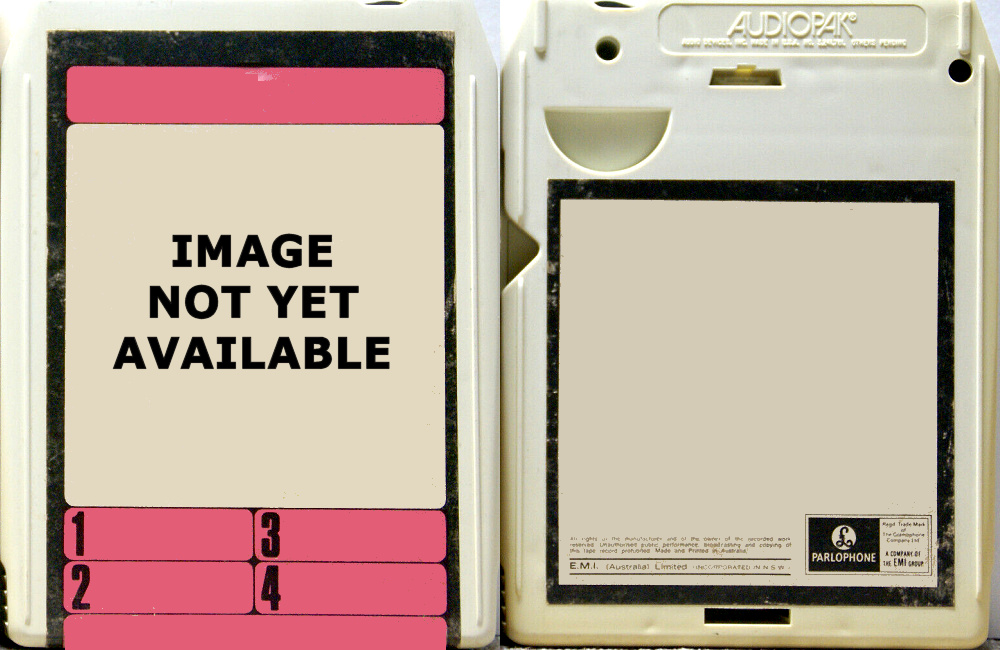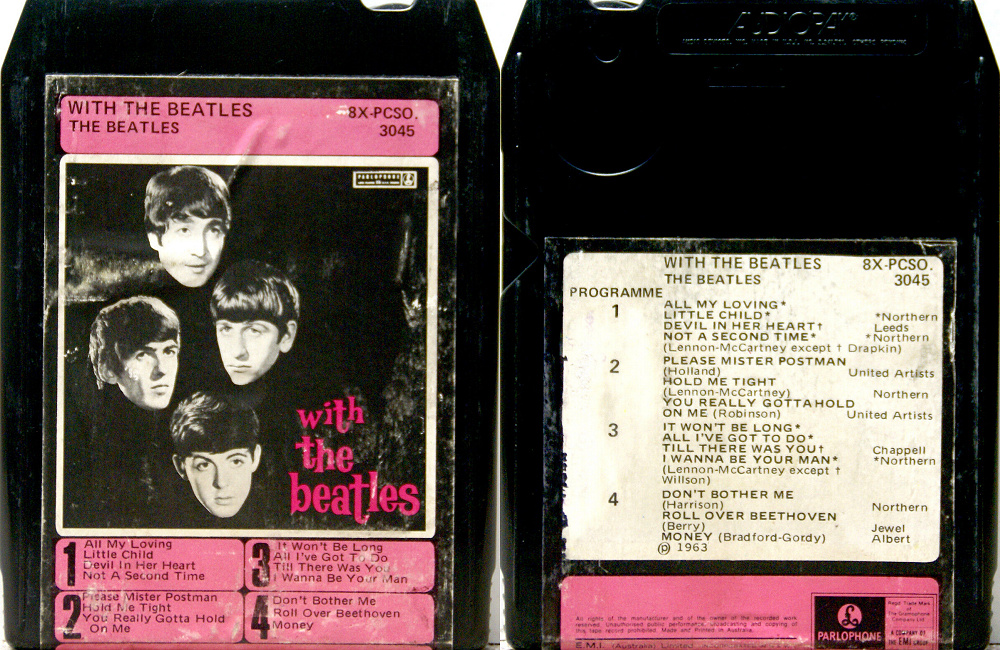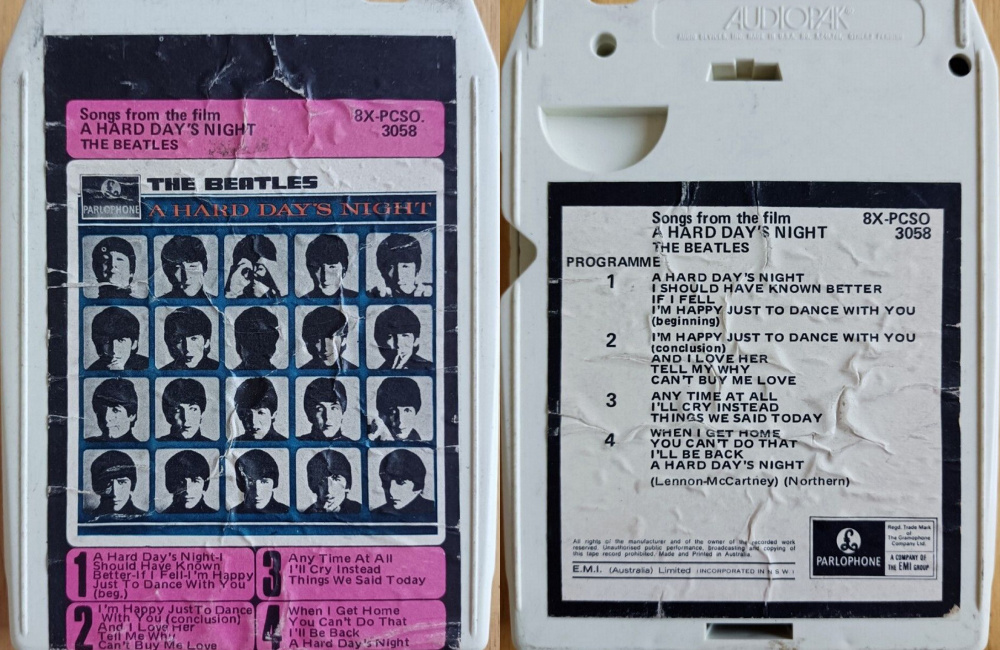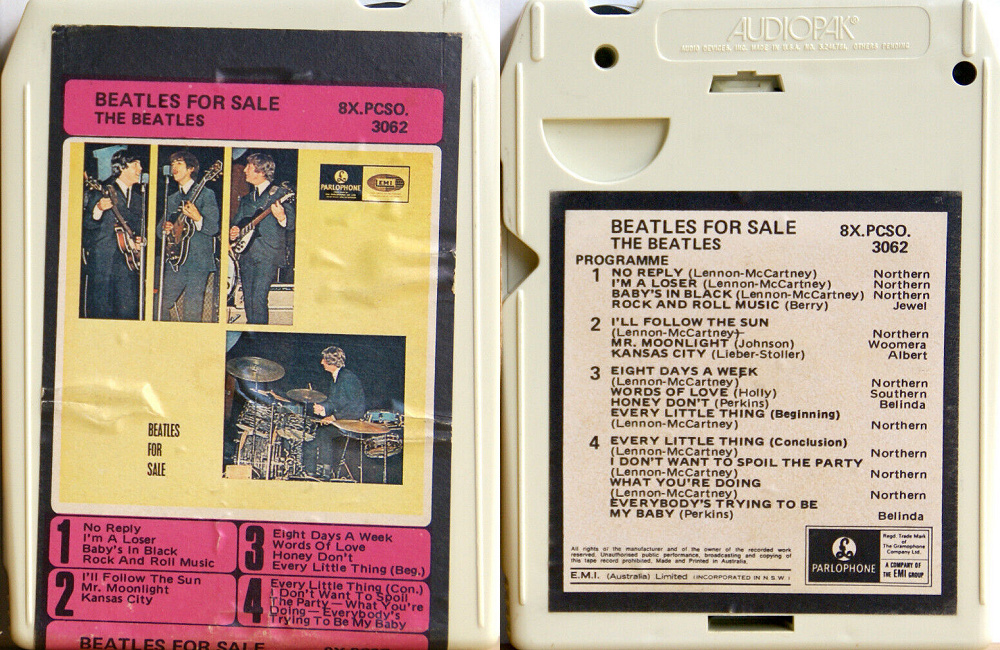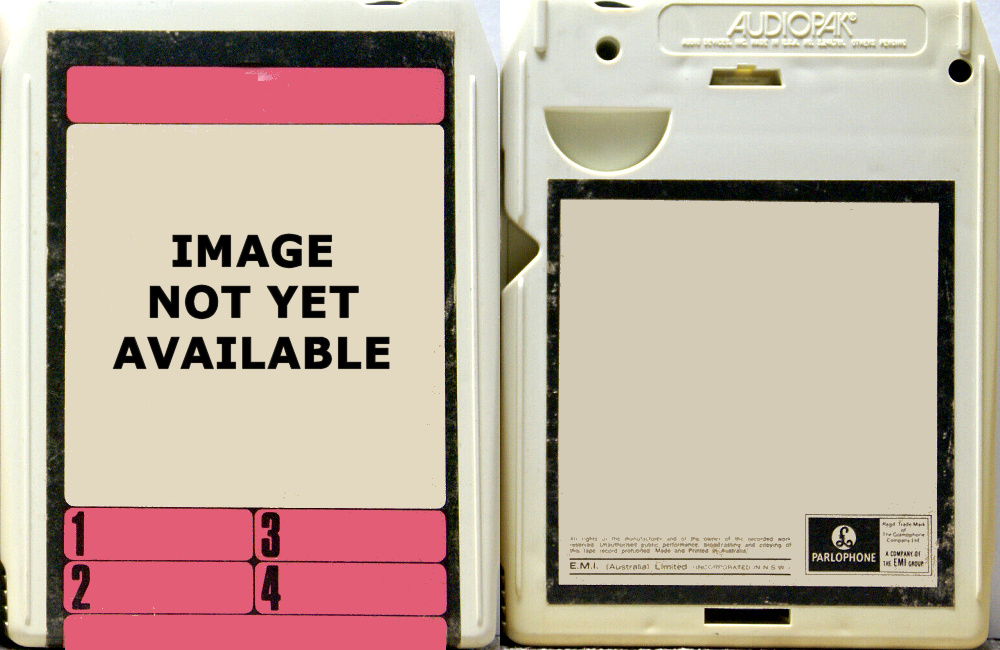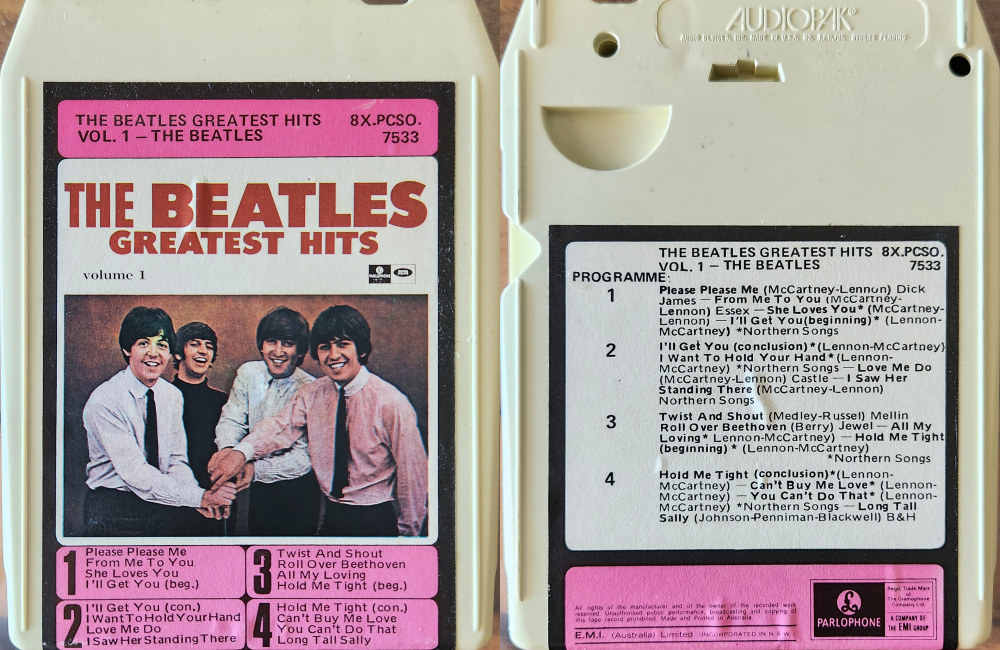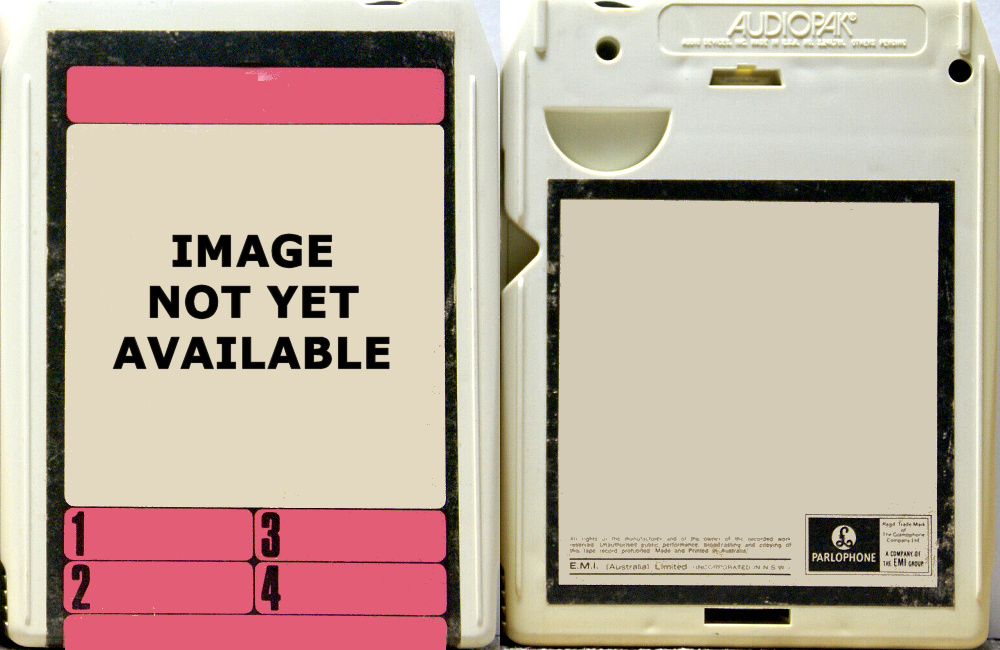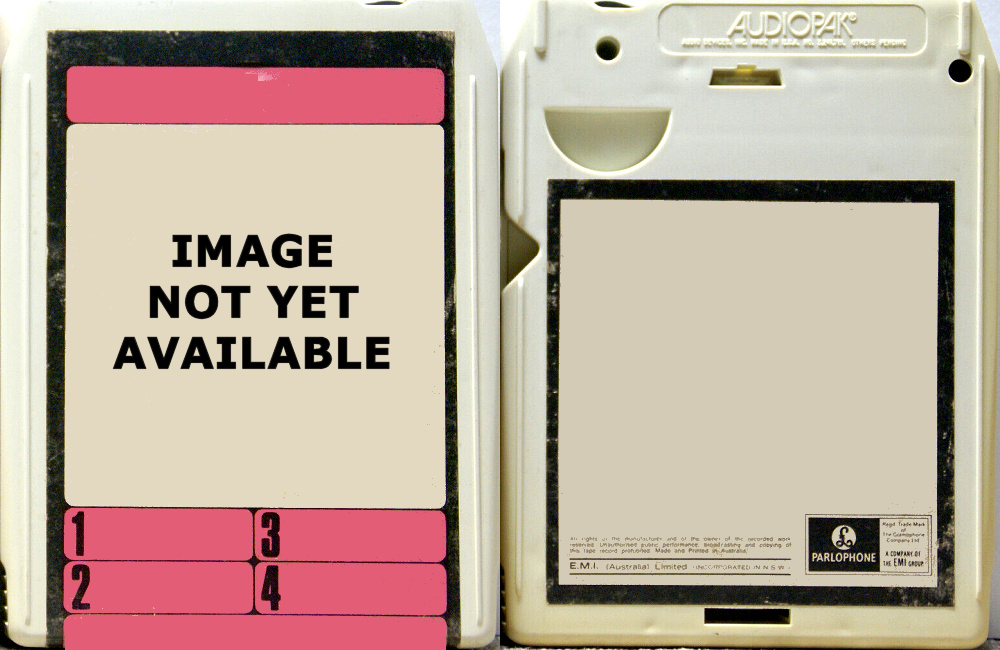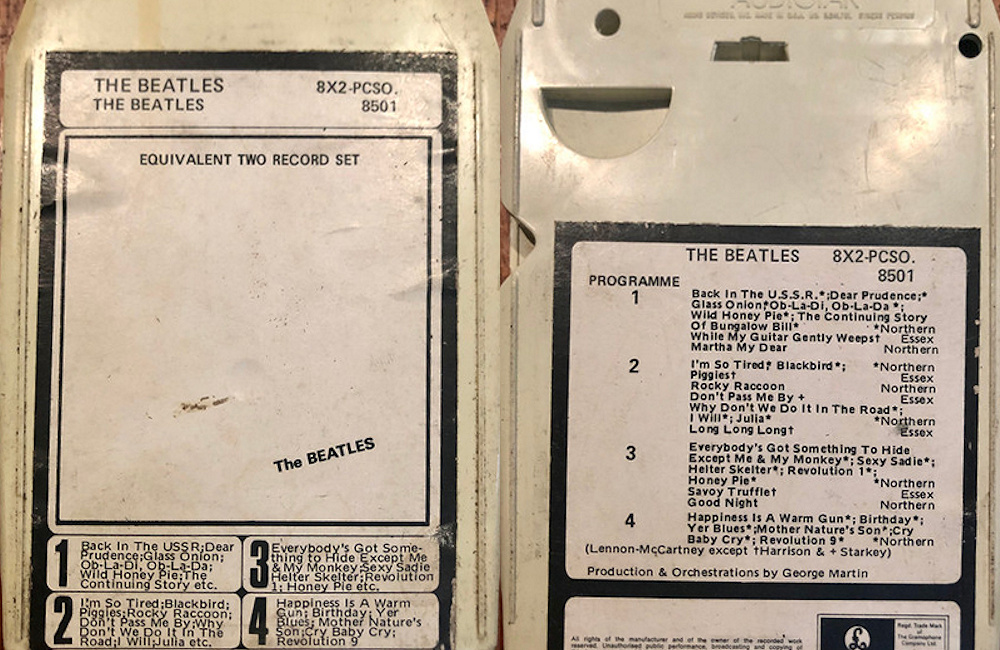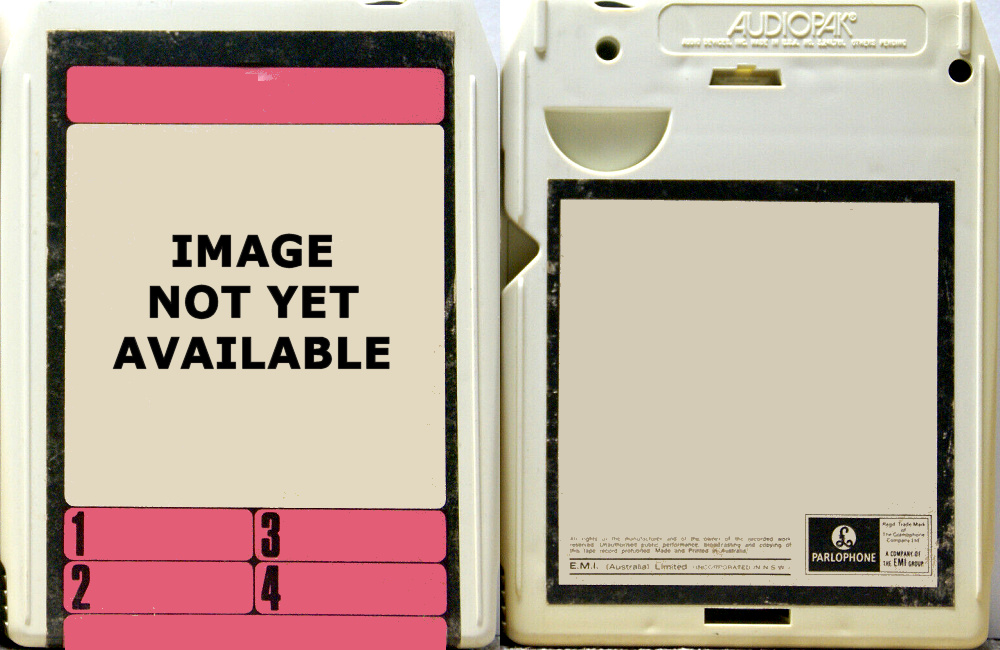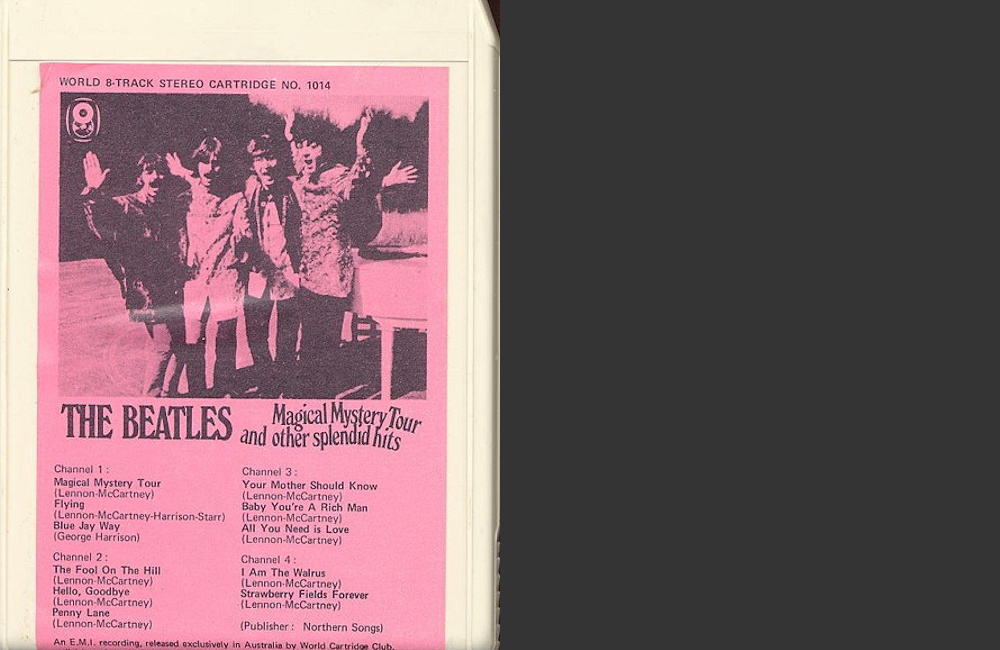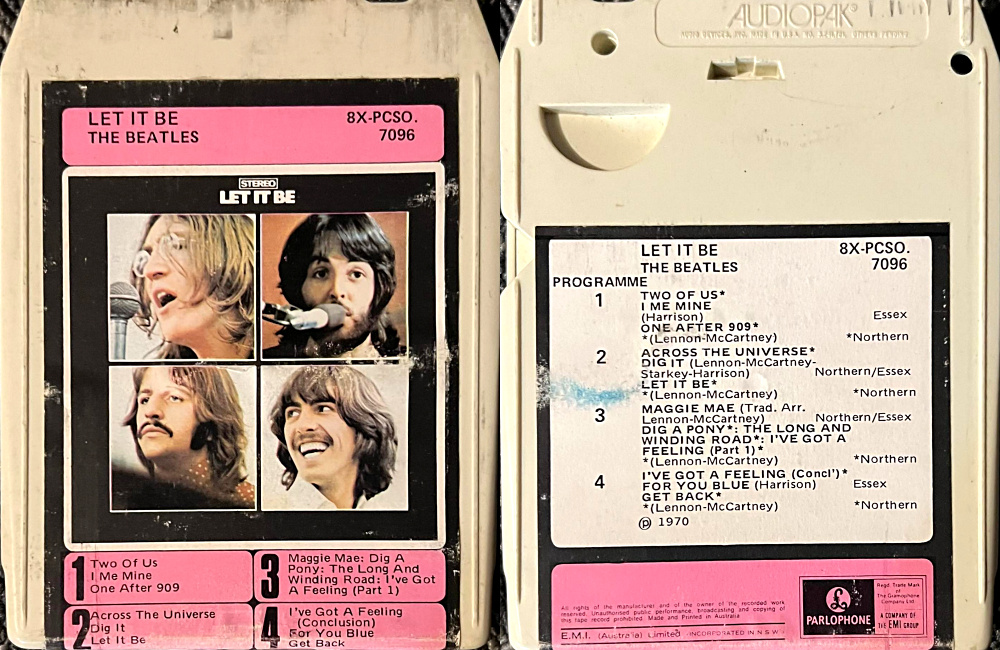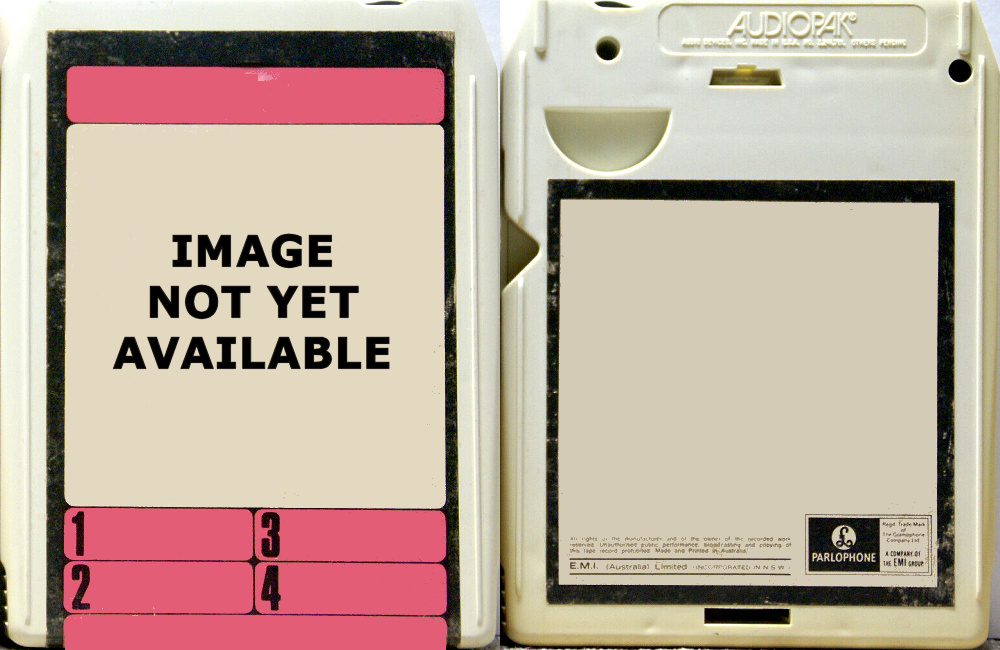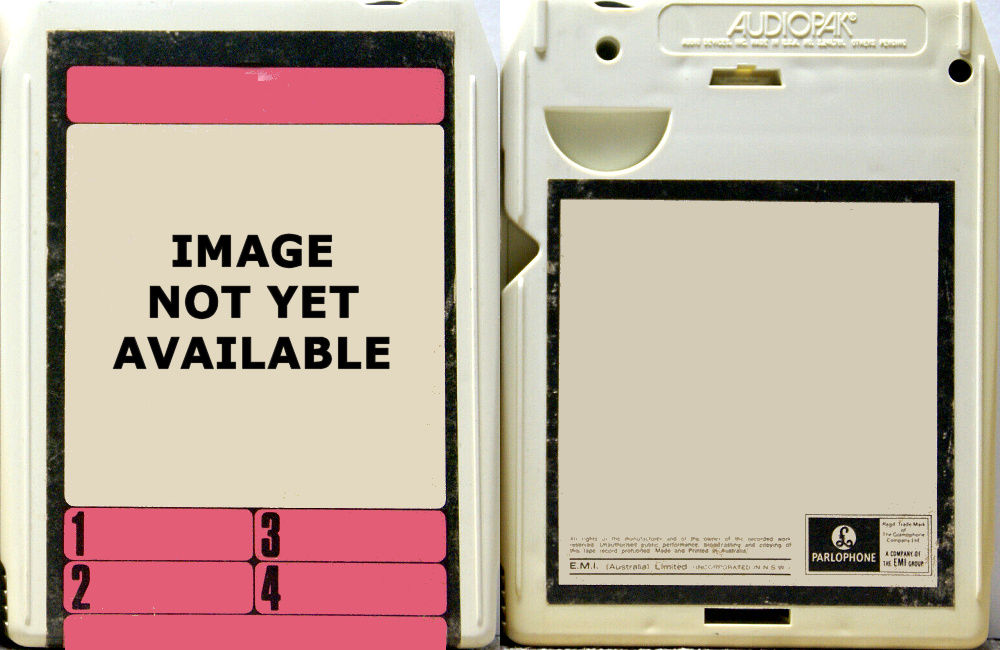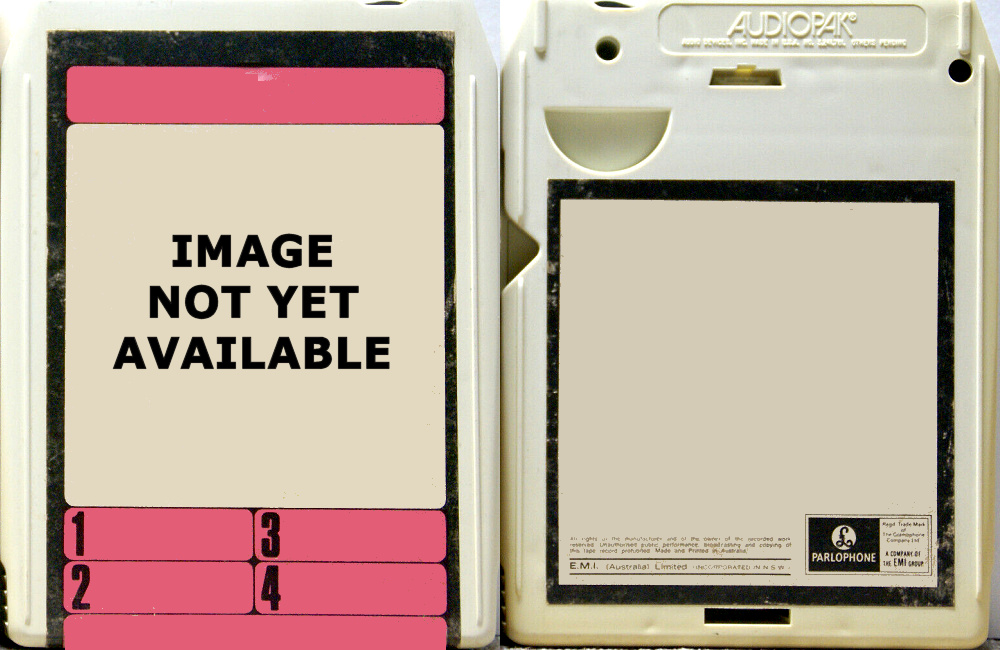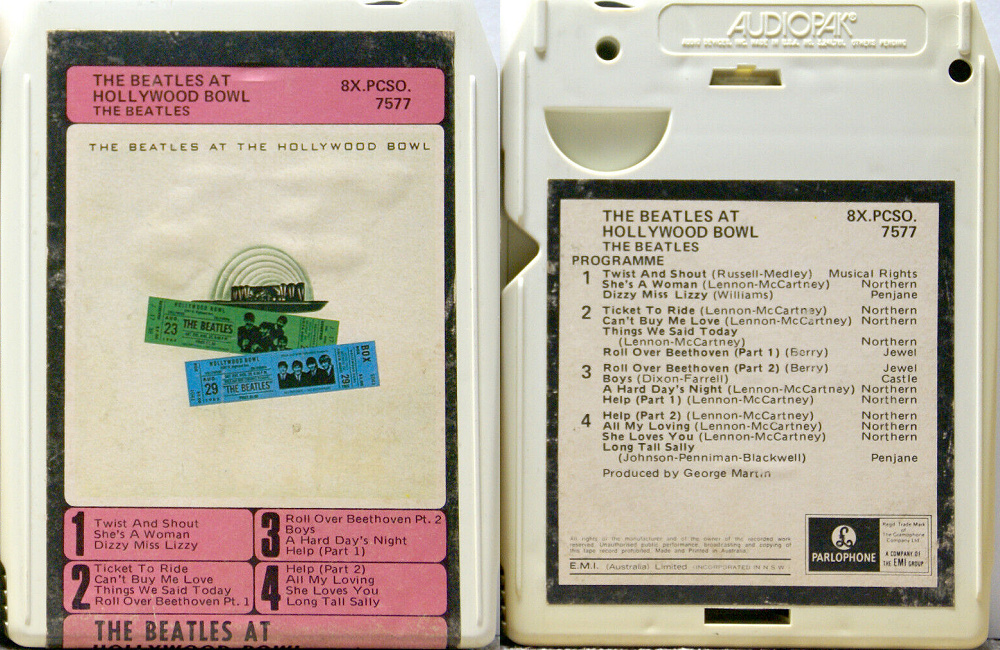8 Track Cartridge
The 8 track cartridge format was jointly developed by Ampex Magnetic Company, RCA Records and Lear Jet Company primarily as a dashboard-based music system for the booming car market. The format was launched in the USA in September 1965, with RCA Victor releasing 175 titles and the Ford Motor Company announcing the format as an option on many of its new 1966 car models. Not long after, players designed for the home began to appear, often incorporated into Reel-to-Reel players.
8 track stereo cartridges comprised four parallel pairs of two-channel stereo programmes: tracks 1 and 5 comprised the first section, 2 and 6 the second, 3 and 7 the third, and 4 and 8 the fourth section. Tracks 1 through 4 were heard through the left speaker while tracks 5 through 8 were heard through the right speaker. All four sections were approximately equal in length and played automatically in sequence. The similar section length often meant that albums had to be re-sequenced to fit the medium, or, in some instances, having songs added, edited or repeated. Conversely, it could also result in long periods of silence between sections.
Australians would first see the format via imports from the USA, either through major record companies or independent music stores. As EMI UK did not commence manufacture of cartridges until November 1969, early EMI (Australia) offerings were sourced exclusively from US labels Capitol and London, commencing late 1968. Such cartridges had a recommended retail price of $6.95 and $7.50 respectively. EMI (Australia) continued to import cartridges while installing a tape duplicating facility of its own at its Homebush factory. EMI (Australia) installed the Gauss Series 1200 System, consisting of a Model 1260 Loop Bin, Model 1210 Master Reproducer and Model 1220 Slave Recorders - see image on the "Cassette" page. EMI (Australia) commenced local manufacture of cartridges in 1971, although imported titles continued to form the bulk of its cartridge offerings throughout that year. Shells were largely imported from the USA and assembled locally.
As at July 1971, EMI (Australia) offered the following Beatles titles on 8 track cartridge:
-Abbey Road (UK import 8X-PCS.7088)
-Hey Jude! (UK import 8X-CPCS.106)
-Let It Be (UK import 8X-PCS.7096)
-Sgt. Pepper's Lonely Hearts Club Band (UK import 8X-PCS.7027)
-Yellow Submarine (US import 8XW-153)
Over the next few years, EMI (Australia) would reissue almost all back-catalogue Beatles albums on the cartridge format—Yellow Submarine and Magical Mystery Tour were left to imports only—along with new Beatles releases.
Meanwhile, The World Cartridge Club (WCC)—a Division of Australia's World Record Club—commenced producing 8 track cartridges in March 1970. The Beatles' Magical Mystery Tour And Other Splendid Hits featured in its initial batch of 24 releases.
However, unlike in the USA where the format was warmly embraced by the public, here in Australia it never reached the same level of acceptance as the cassette. Part of the reason was due to the local motor industry almost exclusively including cassette players rather than cartridge players in new cars. Further, improvements to the cassette format, specifically the introduction of Dolby noise reduction and improved tape quality, saw it firmly cement itself as the preferred tape format. Cassettes also had other advantages: although its tape—like that in the cartridge—could snarl up, it could often be easily untangled by anyone with a pencil, rather than a full operation required for a cartridge. Cassettes were smaller and cheaper to make, and players were more reasonably priced. The 8 track cartridge also had other technical issues: wow and flutter caused by the constantly changing load, an almost inevitable side effect of the sliding tape package. There were more jams as the tape got dirty faster and the lubricant wore out, which happened more often when the temperature rose. Overheating was unavoidable, either in a Hi-Fi stack or when the player was inside a hot car. The cartridge's pinch-roller would also get flattened over time, especially if an 8 track tape was left in the player overnight, which again added to flutter and sound distortion. And, while 8 track cartridges had the advantage of not needing to be turned over, they couldn't be rewound and songs would often be split across tracks, resulting in an annoying mechanical clunk sound mid-song!
The last 'new' Beatles album released on 8 track in Australia was The Beatles At The Hollywood Bowl, in May 1977. The WCC, as its swansong, reissued Magical Mystery Tour And Other Splendid Hits in August 1977. But alas, by the end of 1977, both EMI (Australia) and the World Record Club had dropped the format altogether, diverting their resources to the burgeoning cassette format.
Images of Beatles cartridges showing their 'unique' tracklistings can be seen below - click the arrows to move back and forwards.
8 track stereo cartridges comprised four parallel pairs of two-channel stereo programmes: tracks 1 and 5 comprised the first section, 2 and 6 the second, 3 and 7 the third, and 4 and 8 the fourth section. Tracks 1 through 4 were heard through the left speaker while tracks 5 through 8 were heard through the right speaker. All four sections were approximately equal in length and played automatically in sequence. The similar section length often meant that albums had to be re-sequenced to fit the medium, or, in some instances, having songs added, edited or repeated. Conversely, it could also result in long periods of silence between sections.
Australians would first see the format via imports from the USA, either through major record companies or independent music stores. As EMI UK did not commence manufacture of cartridges until November 1969, early EMI (Australia) offerings were sourced exclusively from US labels Capitol and London, commencing late 1968. Such cartridges had a recommended retail price of $6.95 and $7.50 respectively. EMI (Australia) continued to import cartridges while installing a tape duplicating facility of its own at its Homebush factory. EMI (Australia) installed the Gauss Series 1200 System, consisting of a Model 1260 Loop Bin, Model 1210 Master Reproducer and Model 1220 Slave Recorders - see image on the "Cassette" page. EMI (Australia) commenced local manufacture of cartridges in 1971, although imported titles continued to form the bulk of its cartridge offerings throughout that year. Shells were largely imported from the USA and assembled locally.
As at July 1971, EMI (Australia) offered the following Beatles titles on 8 track cartridge:
-Abbey Road (UK import 8X-PCS.7088)
-Hey Jude! (UK import 8X-CPCS.106)
-Let It Be (UK import 8X-PCS.7096)
-Sgt. Pepper's Lonely Hearts Club Band (UK import 8X-PCS.7027)
-Yellow Submarine (US import 8XW-153)
Over the next few years, EMI (Australia) would reissue almost all back-catalogue Beatles albums on the cartridge format—Yellow Submarine and Magical Mystery Tour were left to imports only—along with new Beatles releases.
Meanwhile, The World Cartridge Club (WCC)—a Division of Australia's World Record Club—commenced producing 8 track cartridges in March 1970. The Beatles' Magical Mystery Tour And Other Splendid Hits featured in its initial batch of 24 releases.
However, unlike in the USA where the format was warmly embraced by the public, here in Australia it never reached the same level of acceptance as the cassette. Part of the reason was due to the local motor industry almost exclusively including cassette players rather than cartridge players in new cars. Further, improvements to the cassette format, specifically the introduction of Dolby noise reduction and improved tape quality, saw it firmly cement itself as the preferred tape format. Cassettes also had other advantages: although its tape—like that in the cartridge—could snarl up, it could often be easily untangled by anyone with a pencil, rather than a full operation required for a cartridge. Cassettes were smaller and cheaper to make, and players were more reasonably priced. The 8 track cartridge also had other technical issues: wow and flutter caused by the constantly changing load, an almost inevitable side effect of the sliding tape package. There were more jams as the tape got dirty faster and the lubricant wore out, which happened more often when the temperature rose. Overheating was unavoidable, either in a Hi-Fi stack or when the player was inside a hot car. The cartridge's pinch-roller would also get flattened over time, especially if an 8 track tape was left in the player overnight, which again added to flutter and sound distortion. And, while 8 track cartridges had the advantage of not needing to be turned over, they couldn't be rewound and songs would often be split across tracks, resulting in an annoying mechanical clunk sound mid-song!
The last 'new' Beatles album released on 8 track in Australia was The Beatles At The Hollywood Bowl, in May 1977. The WCC, as its swansong, reissued Magical Mystery Tour And Other Splendid Hits in August 1977. But alas, by the end of 1977, both EMI (Australia) and the World Record Club had dropped the format altogether, diverting their resources to the burgeoning cassette format.
Images of Beatles cartridges showing their 'unique' tracklistings can be seen below - click the arrows to move back and forwards.
